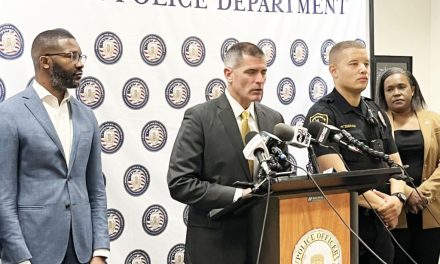Atlanta-based sculptor Basil Watson’s statue of John Lewis. (EIJ)
” data-medium-file=”https://www.birminghamtimes.com/wp-content/uploads/2024/11/Lewis2-300×155.jpg” data-large-file=”https://www.birminghamtimes.com/wp-content/uploads/2024/11/Lewis2-1024×528.jpg” tabindex=”0″ role=”button” />
eji.org
A statue of civil rights champion John Lewis was unveiled Tuesday at Legacy Plaza in downtown Montgomery, Alabama—steps from the culmination of the Selma to Montgomery voting rights march that was launched into the national spotlight when police attacked Lewis and other peaceful protestors on what became known as Bloody Sunday.
“John Lewis inspired so many of us to do the justice work we do today,” said EJI director Bryan Stevenson. “His humility, dedication, and commitment to fighting for people who are excluded and disfavored is a model and legacy urgently needed today. We are thrilled to honor his life and leadership at Legacy Plaza.”
The statue, entitled Steadfast Stride Toward Justice, is the first life-sized sculpture of John Lewis in Alabama, his home state. It is the third sculpture at Montgomery’s Legacy Plaza joining other Civil Rights giants, Rosa Parks and Dr. Martin Luther King Jr. The sculptures were created by acclaimed Atlanta-based Basil Watson, who attended the unveiling along with members of the Lewis family and local officials.
Lewis and leaders of the Southern Christian Leadership Conference (SCLC) and the Student Non-Violent Coordinating Committee (SNCC) organized a march from Selma to Montgomery to challenge the denial of voting rights to Black people in Alabama.
Lewis stood at the front when state troopers violently attacked the marchers with whips and clubs, brutally beating scores of peaceful protestors. He suffered a fractured skull and was hospitalized.
On March 25, 1965, Lewis joined Dr. Martin Luther King Jr. on the steps of the capitol in Montgomery to address thousands of nonviolent protestors who had marched 54 miles from Selma.
The marchers’ historic entry into Montgomery ultimately resulted in the passage of the Voting Rights Act of 1965, which dramatically shifted political power throughout most of the South.
The “Boy from Troy”
Lewis was born in 1940 near Troy, Alabama, about 50 miles from Montgomery, where his parents worked as sharecroppers before purchasing their own land to farm, as reported by The New York Times.
As a high school student, he was inspired by the actions of Rosa Parks and the words of Dr. King, he told his friend Valerie Jackson at StoryCorps, and asked himself, “If something can happen like this in Montgomery, why can’t we change Troy?” He wrote a letter to Dr. King, who sent him a bus ticket to Montgomery. At 18, he recalled feeling scared to meet Dr. King.
” data-medium-file=”https://www.birminghamtimes.com/wp-content/uploads/2024/11/Lewis-300×149.jpg” data-large-file=”https://www.birminghamtimes.com/wp-content/uploads/2024/11/Lewis.jpg” tabindex=”0″ role=”button” class=”wp-image-124422 size-full” src=”https://www.birminghamtimes.com/wp-content/uploads/2024/11/Lewis.jpg” alt=”” width=”801″ height=”397″ srcset=”https://www.birminghamtimes.com/wp-content/uploads/2024/11/Lewis.jpg 801w, https://www.birminghamtimes.com/wp-content/uploads/2024/11/Lewis-300×149.jpg 300w, https://www.birminghamtimes.com/wp-content/uploads/2024/11/Lewis-768×381.jpg 768w, https://www.birminghamtimes.com/wp-content/uploads/2024/11/Lewis-640×317.jpg 640w, https://www.birminghamtimes.com/wp-content/uploads/2024/11/Lewis-681×338.jpg 681w” sizes=”(max-width: 801px) 100vw, 801px” />
I didn’t know what to say or what to do. And Dr. King said, “Are you the boy from Troy?” And I said, “Dr. King, I am John Robert Lewis.” I gave my whole name. But he still called me the ‘boy from Troy.’
Lewis worked as a dishwasher and janitor to pay his tuition at American Baptist Theological Seminary in Nashville, where he learned the principles of nonviolent protest and immediately deployed them.
During the successful campaign to end segregated lunch counters in Nashville, he earned what he later called his first “badge of honor”—the first of at least 40 arrests for demonstrating against segregation and racial inequality.
Getting arrested did not deter Lewis from the pursuit of justice—and neither did the brutal beatings he suffered from segregationists. It was also in Montgomery that, as a Freedom Rider in 1961, he was beaten unconscious. As he put it later:
“We were arrested. We were jailed. We were beaten. But I guess in the end we knew and realized that we changed things. My philosophy is very simple. When you see something that is not right, not fair, not just — you have to stand up, you have to say something, you have to do something”
In 1986, Lewis was elected to Congress, where he represented Atlanta and worked tirelessly to end poverty, racism, and war.
“In these days that seem to be so dark, I think the spirit of history is still leading us and guiding us—I believe in that,” he said in 2016. “Call it what you may, but I believe that somehow, in some way, good is going to prevail. And out of some of the darkest hours, there will be daybreak. There will be light. And we will get there.”
Honoring Local Heroes at Legacy Plaza
” data-medium-file=”https://www.birminghamtimes.com/wp-content/uploads/2024/11/JOHN-257×300.jpg” data-large-file=”https://www.birminghamtimes.com/wp-content/uploads/2024/11/JOHN-878×1024.jpg” tabindex=”0″ role=”button” class=”size-medium wp-image-124424″ src=”https://www.birminghamtimes.com/wp-content/uploads/2024/11/JOHN-257×300.jpg” alt=”” width=”257″ height=”300″ srcset=”https://www.birminghamtimes.com/wp-content/uploads/2024/11/JOHN-257×300.jpg 257w, https://www.birminghamtimes.com/wp-content/uploads/2024/11/JOHN-878×1024.jpg 878w, https://www.birminghamtimes.com/wp-content/uploads/2024/11/JOHN-768×896.jpg 768w, https://www.birminghamtimes.com/wp-content/uploads/2024/11/JOHN-1317×1536.jpg 1317w, https://www.birminghamtimes.com/wp-content/uploads/2024/11/JOHN-1756×2048.jpg 1756w, https://www.birminghamtimes.com/wp-content/uploads/2024/11/JOHN-360×420.jpg 360w, https://www.birminghamtimes.com/wp-content/uploads/2024/11/JOHN-300×350.jpg 300w, https://www.birminghamtimes.com/wp-content/uploads/2024/11/JOHN-341×400.jpg 341w, https://www.birminghamtimes.com/wp-content/uploads/2024/11/JOHN-640×746.jpg 640w, https://www.birminghamtimes.com/wp-content/uploads/2024/11/JOHN-681×794.jpg 681w” sizes=”(max-width: 257px) 100vw, 257px” />
Legacy Plaza showcases a statue of Rosa Parks, whose December 1, 1955, arrest in Montgomery famously launched the bus boycott that she led alongside Dr. King, Jo Ann Robinson, E.D. Nixon, and other activists, was unveiled in February.
In June, Mrs. Parks’s statue was joined by a full-sized statue of Dr. Martin Luther King Jr.—the first in Montgomery.
It is especially fitting to honor these three extraordinary people together in Montgomery, where Lewis first met Rosa Parks and Dr. King and was inspired to “get into trouble, good trouble, necessary trouble” in the pursuit of justice.
Located across the street from the Legacy Museum, Legacy Plaza is a gathering place for visitors to EJI’s Legacy Sites. The plaza is also a place to honor and learn more about the people whose courageous resistance to racial discrimination and segregation in Montgomery inspired a national movement for civil rights, justice, and equality that continues today.
In addition to the statues of Mrs. Parks, Dr. King, and Rep. Lewis, the plaza features a brick sculpture memorializing civil rights marchers and a mural by local artist Kevin King.











